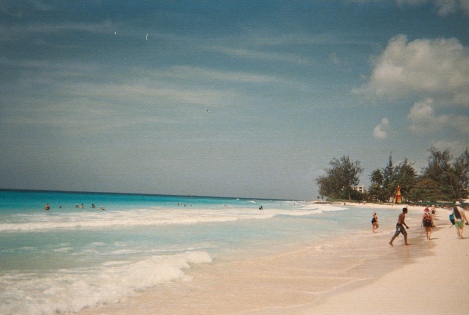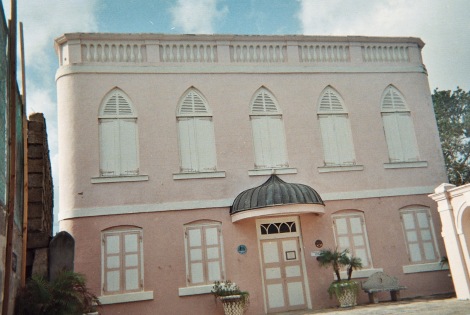
With its white sandy beaches, blue skies, and year-long warm weather, it’s difficult to imagine that the island of Barbados was once home to a thriving Spanish and Portuguese Jewish community. Top hats and morning suits seem at odds with the surrounding environment, and yet, the physical remnants of this Jewish community make it clear that Jews once found a way to not only live on this island, but for a time to even thrive there. The original community was at its height of activity in the eighteenth century when there were perhaps as many as a thousand Jews living there. It was during the boom years of the sugar industry. However, with the industry’s decline in the nineteenth century, the community slowly moved away.

Nidhe Israel – Bridgetown, Barbados
The name of the community was Nidhe Israel, the ‘Scattered of Israel.’ It may have been a reference to the founders of the community, many of whom were refugees from fallen Dutch Brazil in 1654 (similar to Shearith Israel, ‘Remnant of Israel’ in New Amsterdam/York). They constructed their lovely synagogue at that time, making it the first in the British Empire, long before even Bevis Marks Synagogue in London. It is not only the oldest remaining synagogue in the New World, but also the most impressive Spanish & Portuguese religious complex I’ve ever visited. On site there is the synagogue, what used to be the school house (now a visitor centre), the original Mikve (ritual bath), and also the community cemetery, all surrounded by a wall.

Synagogue Lane, Barbados
Amongst the beautiful gravestones was one that made my pulse jump as the name on it was familiar to me. Rabbi Rephael Haim Yitzhak Carigal, was born in Hebron in 1733, though spent much of his adult life traveling to different communities, in an effort to help raise funds for Jews living in Israel. His travels took him so far that he even came to London, and from there to the New World. He subsequently served for a couple of years in Newport RI, at the then newly built Touro Synagogue, where he became friends with Ezra Stiles, future president of Yale University. He then lived for several more years in Barbados, where he died in 1777, and was laid to rest in the community cemetery.

R’ Carigal

Tombstone of Rabbi Rephael Haim Yitzhak Carigal, Barbados
The great condition and accessibility of the property is due to the heroic and dedicated work of Barbadian Sir Paul Altman (recently knighted in England!). Most Jews left the Island by the late nineteenth century (the synagogue archives are now cared for by the London S&P Sephardi Community), and the synagogue was sold off by the last Jew there in 1929. In 1985, when the building was set to be razed, the new Jews of the Island petitioned for its preservation and it was handed over to the National Trust. Sir Paul (his family arrived on the island from Poland in 1931) spearheaded the efforts that restored the synagogue (making it look as it once did), established the visitor centre, and even unearthed a forgotten Mikve. He is now coordinating efforts to expand the synagogue property to include a new community hall and public park.

Mikve, Barbados
The community today is made up of thirty individuals. The modern-day inhabitants of the synagogue do not follow the rite of the Spanish & Portuguese Jews (nor is their service Orthodox), though they are deeply committed to keeping the memory of the original founders alive, and to maintaining a Jewish community. They welcome visitors to join them for Shabbat evening services. The history of the local Sephardic community is researched by the incredibly friendly and hard working local historian Dr. Karl Watson. I thank him and Sir Paul for taking the time to personally share their passion with me when I visited in February 2016.

Dr Karl Watson, Sir Paul Altman, and me
As someone who loves the history and traditions of the Spanish and Portuguese Jews, I am grateful to the new Jewish community of Barbados for all they have done to restore and protect the site. Thanks to their efforts it continues to inform historians and to inspire visitors. As I walked the grounds of Nidhe Israel, I imagined its once bustling activity. I could see people coming from synagogue, children studying in the school, and funeral circuits in the cemetery. It must have been a dynamic setting with the entire cycle of Jewish life sharing the same space, energising all those who lived there. While much of that activity is now in the past, I found that it is still very much present for those who wish to see it.
Your description of Barbados is very evocative indeed and brought me straight back to my native Suriname which I would strongly recommend to include in your next visit to the region. Perhaps you will then settle the matter of the first/oldest remaining synagogue in the Americas – Jodensavanne (1685) lays claim to that. Many thanks for informing readers of Ribbi Carigal, a fascinating person who did ever such a lot for the good standing of Jews. I have not been able to trace the source but I was taught that R. Carigal had a letter of recommendation of the Va’ad from Hevron, stating, a.i., that the bearer was a man of tremendous wisdom who nevertheless had the courage to say “I don’t know”.
Thank you for the lovely feedback. I look forward to traveling to Suriname. I’m hoping to make it there next winter!
Most interesting
Thanks for sharing
Janet Horwitz
Thank you. So pleased you enjoyed! Best, Shalom
Thank you. This is really interesting. Marlena Schmool
>
My pleasure. Thank you for the kind words!
Rabbi Morris, thank you for the wonderful article about Barbados. I loved your picture and it looks like you had a wonderful trip. I look forward to receiving you email
and they are so interesting. Yours, Marge Kirchheimer
________________________________
Thank you for your very kind words! I’m so glad you enjoy reading them!
Dear Rabbi Morris, thank you for your very interesting report on the Esnoga Nidhe Israel in Barbados with its accompanying photographs. Just two quick comments. There are still many descendants of the old seventeenth century Sephardic families in Barbados, but as often happens in our small islands, they are disguised through a series of various inter marriages. Secondly, though the footprint and the floor/ base of the present synagogue are the original ones of 1654, the damage to the roof of the building in the hurricane of 1831 weakened the walls and on the advice of the builders, they were taken down almost to floor level and rebuilt. The splendid mikve or bano is without doubt, the oldest in the Americas.
Thank you Dr Watson for those important clarifications. Your insights are most appreciated!
Wonderful article. Thank you and hope that you return soon to Barbados.
Thank you! I look forward to it 🙂
Do not forget thst Curacao’s Mikve Israel synagogue is the Oldest in CONTINUOUS use in the Western Hemisphere! This is FACT, not CONJECTURE!
Thank you for the clarification. I look forward to visiting Curacao and the kahal, perhaps next winter!
We look forward to your visit! Pleae do communicate with us.
Excellent article. Although I’m not from Barbados I am S&P and love to read about other S&P esnogas.
Thank you for the kind words. Let me know when you are in London to visit Bevis Marks.
A pleasing article.
Thank you for the kind feedback. I’m so pleased you enjoyed it!
Pingback: A Bit Of Our Heritage | beautifulbarbadosblog·
Pingback: Beginning Year Two – Consolidating and Expanding | Shalom Says Hello·
Pingback: Curacao – The Caribbean’s Jewish Island | Shalom Says Hello·
Pingback: The Nidhe Israel Synagogue Mikveh, Bridgetown, Barbados - 1654 | Bajan Things·